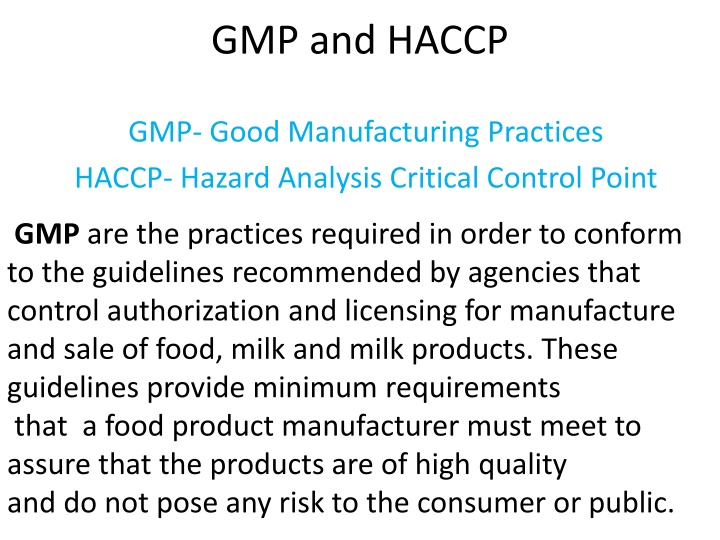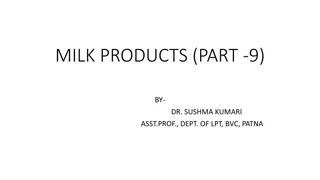
Implementing GMP and HACCP for Food Safety
Learn about Good Manufacturing Practices (GMP) and Hazard Analysis Critical Control Point (HACCP) systems that ensure quality and safety in food production. Discover the key principles, guidelines, and benefits of integrating GMP and HACCP in the dairy industry, as well as the regulations surrounding organic milk products.
Uploaded on | 5 Views
Download Presentation

Please find below an Image/Link to download the presentation.
The content on the website is provided AS IS for your information and personal use only. It may not be sold, licensed, or shared on other websites without obtaining consent from the author. If you encounter any issues during the download, it is possible that the publisher has removed the file from their server.
You are allowed to download the files provided on this website for personal or commercial use, subject to the condition that they are used lawfully. All files are the property of their respective owners.
The content on the website is provided AS IS for your information and personal use only. It may not be sold, licensed, or shared on other websites without obtaining consent from the author.
E N D
Presentation Transcript
GMP and HACCP GMP- Good Manufacturing Practices HACCP- Hazard Analysis Critical Control Point GMP are the practices required in order to conform to the guidelines recommended by agencies that control authorization and licensing for manufacture and sale of food, milk and milk products. These guidelines provide minimum requirements that a food product manufacturer must meet to assure that the products are of high quality and do not pose any risk to the consumer or public.
This good manufacturing practices that should be followed by dairy plant owners, operators and employees to maximally assure the production of safe and sanitary products at all times. The guideline offers suggestions for measures and precautions that should be taken regarding employee health, food handling practices, appearance, personal hygiene, plant procedures, plant and equipment design, maintenance, and sanitation.
HACCP Hazard Analysis and Critical Control Point (HACCP) System -In order to enhance food safety, every stage of the food production (from purchasing, receiving, transportation, storage, preparation, handling, cooking to serving) should be carried out and monitored scrupulously. The HACCP system is a scientific and systematic approach to identify, assess and control of hazards in the food production process. .
With the HACCP system, food safety control is integrated into the design of the process rather than relied on end- product testing. Therefore HACCP system provides a preventive and thus cost-effective approach in food safety
The seven principles of a HACCP System are- 1.Analyze hazards 2.Determine critical control points 3.Establish limits for critical control points 4.Establish monitoring procedures for critical control points 5.Establish corrective actions 6.Establish verification procedures 7.Establish a record system
Organic milk products Organic milk refers to a number of milk products from livestock raised according to organic farming methods. In most jurisdictions, use of the term "organic" or equivalents like "bio" or "eco", on any product is regulated by food authorities. In general these regulations stipulate that livestock must be: allowed to graze, be fed an organically certified fodder or compound feed, not be treated with most drugs (includinggrowth hormone), and in general must be treated humanely.
Food safety standards for milk and milk products Food Safety and Standards Authority of India (FSSAI) is an autonomous body established under the Ministry of Health & Family Welfare, Government of India. The FSSAI has been established under the Food Safety and Standards Act, 2006 which is a consolidating statute related to food safety and regulation in India. FSSAI is responsible for protecting and promoting public health through the regulation and supervision of food safety.
The FSSAI has its headquarters at New Delhi. The authority also has 6 regional offices located in Delhi, Guwahati, Mumbai, Kolkata, Cochin, and Chennai. 14 referral laboratories notified by FSSAI, 72 State/UT laboratories located throughout India.
Fortified milk available at no additional cost! Buy Milk packs marked with "+F" Logo to get all the goodness of milk enriched with Vitamin A & D.
Cleaning and sanitation in milk plant The degree of cleanliness: Physical cleanliness removal of all visible dirt from the surface Chemical cleanliness removal not only of all visible dirt but also of microscopic residues that can be detected by taste or smell but are not visible to the naked eye Bacteriological cleanliness attained by disinfection Sterile cleanliness destruction of all microorganisms
In dairy cleaning operations, the objective is nearly always to achieve both chemical and bacteriological cleanliness. The equipment surfaces are therefore first thoroughly cleaned with chemical detergents and then disinfected. A film of milk adheres to the walls of pipelines, pumps, tanks, etc. ('cold' surfaces). When a system is emptied, cleaning should start as soon as possible, or otherwise this film will dry out and be harder to remove.
CIP ( Clean In Place) has been opted in milk industry for good cleaning and sanitation. The cleaning cycle in dairy comprises following steps- Recovery of product residue by scrapping, drainage with water or compressed air. Pre- rinsing with water (< 55C) to remove dirt. Cleaning with alkaline detergent. Rinsing with clean water. Cleaning with acidic detergent. Rinsing with clean water














